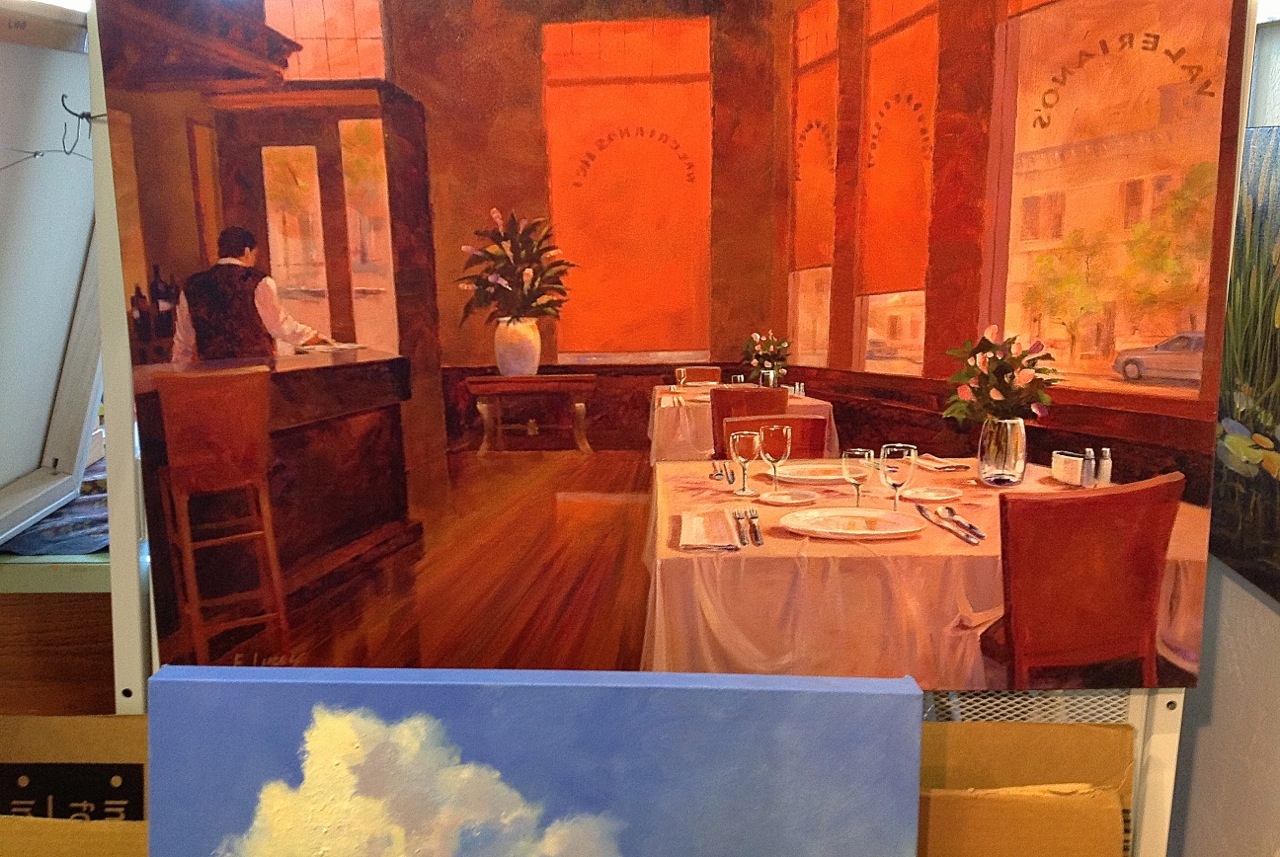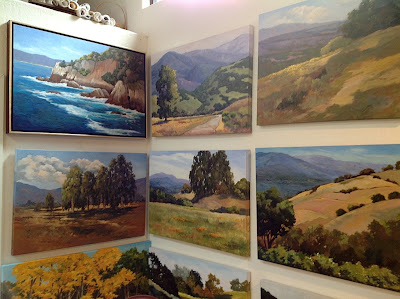 |
American tourists viewing canvases by Henri Matisse at
The Hermitage in St. Petersburg, Russia, 2009 |
My friend Mary decided a few years back to redecorate her house with original art. Since her budget is limited, she decided to use work by local artists. "It's amazing how much good art is being produced right here in Silicon Valley," she commented recently over coffee, "and you wouldn't believe the variety!" She checks out the work at various art/wine/craft festivals during the summer season, but she says that her best luck has been with Open Studio events, like SVOS (see side panel). "Last year I got a really cute little pastel for my daughter's room. For my dining room, I got a landscape with a gorgeous sunset." She enjoys visiting the artists in their studios because she feels like she is exploring new worlds and discovering treasures to take home with her.
"The only problem is, I can't talk about art. If someone asks me why I like something, I'm like…'uhhh, I don't know. I just like it.' I wish I could communicate better."
There are only so many things you can like about a painting or other work of flat art to hang on the wall. Let's see if we can analyze them. "How do I love thee? Let me count the ways."
The quality that generally attracts me first is the combination and balance of the
colors; certain colors are special to me in art, just as in the clothes I wear and the decoration of my home.
 |
Au Café (Synchromy), 1918 by Stanton Macdonald-Wright
Crystal Bridges Museum, Bentonville, Arkansas
If you look long enough you can make out a man and woman having coffee,
but the painting's appeal is in the array and balance of primary colors. |
Light quality is another big factor for me. I can't resist a devastating sunset, rays of light penetrating a forest, or any sort of magical light.
 |
Washington Street, Indianapolis at Dusk, 1895 by Theodor Groll
Indianapolis Museum of Art
Twilight in the city when the lights first start to come up
is a magical time that is difficult to convey. |
Sometimes a special
technique appeals to me, perhaps because it looks so difficult, maybe because it is entirely new to me. One of the biggest technical challenges in painting is to convey the sense of touch—the smoothness of satin, the roughness of granite. When the artist gets the
texture right, you imagine it with your fingertips.
 |
Princesse de Broglie, 1853 by Jean-Auguste-Dominique Ingres
Metropolitan Museum of Art, New York
Ingres' technique in conveying the texture of satin and lace is amazing and delightful. |
Most people are probably attracted to certain
subjects, either because they are familiar or because they are strange. Some people can't resist light-houses, roosters, or giraffes, etc. I like a wide range of subjects, but I'm particularly attracted to unique points of view and evocative social settings.
 |
Art Beauty Shoppe, 1934 by Isaac Soyer
Dallas Museum of Art
Scenes from everyday life have a special appeal for me.
This historical scene has a timeless quality. |
Paintings that tell
stories are especially interesting to me, such as a father swinging a toddler on his knee, a woman working in a factory, or a crowd hearing war news on the front steps of the court house. This kind of work is traditionally called
genre painting.
 |
The Love Song, 1926 by Norman Rockwell
Indianapolis Museum of Art
In this story, a guest carrying an umbrella has dropped by the home of a studious
friend to practice an old love song on clarinet and flute. The cleaning
girl pauses to listen and to dream. |
Details sometimes give a painting a special charm: the longer you look at the image, the more you notice. I might like the way a cute dog is added to a scene of courtship, or a tiny city-scape is placed in the background of the portrait of a dignitary.
 |
The Valley of the Wyoming, 1865 by Jasper Francis Cropsey
Metropolitan Museum of Art, New York
This painting is satisfying as a large-scale view,
but at the detail level it is fascinating. |
 |
This is a small section of The Valley of the Wyoming.
No matter how close you get, the details are realistic. |
Paintings that don't have a subject that is recognizably related to reality are
abstractions. They depend entirely on the elements of painting themselves: color, shape, line, texture, arrangement.
 |
Grey, Blue, Black, Pink and Green Circle, 1929
by Georgia O'Keeffe, Dallas Museum of Art
The shapes, colors, and lines are harmonious, but the subject is anybody's guess.
In fact, for appreciating abstractions, imagining the meaning is part of the fun. |
The most powerful aspect of a painting is perhaps the least understood:
composition. The arrangement of elements within the space gives the painting structure and reality. Regarding
structure, paintings frequently have an underlying layout such as a triangle, a circle, or a sweeping curve. As for
reality, if the picture elements—lines, shapes, colors, textures—are not arranged well, the viewer has trouble interpreting the picture's meaning, even at the simplest level. By relative size and positioning of picture elements the artist tells you what is important and what is background.
 |
The Card Sharp with the Ace of Clubs, 1640 by Georges de La Tour
Kimbell Museum of Art, Fort Worth
The composition clarifies the story of the card sharp on the left, the naive
fop on the right, and the hostess of the gambling den in the center,
who directs the waitress to serve wine to the card sharp. |
Closely related to composition is
direction or
dynamic. The artist's objective is to get the viewer's eye to move around the composition. The artist uses line, color and shape to draw your eye from one part of the picture to another. For example, a certain color might be repeated here and there in a certain pattern, or the direction of one line might lead your eye to a another line on the same path, all with respect to that underlying layout.
 |
Undertow, 1896 by Winslow Homer
The Clark Institute, Williamstown, Massachusetts
The placid horizontals of the ocean are violently broken by a downward
thrusting triangle. Each shape connects with another in a continuous arc.
Light patterns draw the eye toward the lifeguard in the upper left,
who is straining with effort and wracked by emotion. |
The culmination of all these factors is
style. The way the painting synthesizes the elements of art expresses the artist's personality, but styles are also subject to changing trends. In some eras of art history, the work of most artists is flat and decorative; in others it is three-dimensional and convincingly real. To run through a description of the styles that have been used throughout history would require a thick book. But you don't have to know all that to appreciate an artist's style.
To a large extent style depends on the way the painter applies the paint. Brush-strokes are like handwriting or fingerprints in being intimately tied to one individual. For instance, van Gogh liked to give each long brush-stroke its own weight.
 |
Grapes, Lemons, Pears, and Apples, 1887 by Vincent van Gogh
Art Institute of Chicago (2010 photo) |
Signac like to apply the paint in dots, each one a different shade.
 |
Notre-Dame-de-la-Garde, Marseilles, 1906 by Paul Signac
The Metropolitan Museum, New York |
Some artists do not want any evidence of the brush.
 |
Virgin and Child, c. 1646 by José Jusepe de Ribera
Philadelphia Museum of Art |
Some artists want absolute control over the placement of the paint.
 |
Vein, 1985 by Bridget Riley
Albright-Knox Museum, Buffalo |
Others like to leave something to chance.
 |
Round Trip, 1957 by Helen Frankenthaler
Albright-Knox Museum, Buffalo |
Another important part of style is the way the artist treats space and dimension. Some artists like to create the illusion of real space and three dimensions.
 |
Rainy Day, 1938 by Yvonne Twining
Oklahoma City Museum of Art |
Some artists flatten space and deny the solidity of objects in order to turn a scene into a pattern.
 |
Three Women, 1922 by Fernand Léger
Museum of Modern Art, New York |
It turns out there are quite a few things you can say about art, a lot more than I thought when I started. In fact, I could go on and on with this!
Analyzing a painting, drawing, or print is a way of enjoying it. How do I love thee, dear seascape over the sofa? Let me count the ways. Your colors are appealing, your light quality is magical, your technique is uncanny, your textures are tingling, your subject matter is relevant, your details are intriguing, your composition is understandable, your dynamics are mesmerizing, your handling of space is convincing, and your style is unique!
By the way, I took these photos of paintings myself last year during tour of 35 U.S. art museums.
For my inspiration I used a poem by Elizabeth Barrett Browning:
How do I love thee? Let me count the ways.
I love thee to the depth and breadth and height
My soul can reach, when feeling out of sight
For the ends of Being and ideal Grace.
I love thee to the level of everyday's
Most quiet need, by sun and candle-light.
I love thee freely, as men strive for Right;
I love thee purely, as they turn from Praise.
I love thee with a passion put to use
In my old griefs, and with my childhood's faith.
I love thee with a love I seemed to lose
With my lost saints, --- I love thee with the breath,
Smiles, tears, of all my life! --- and, if God choose,
I shall but love thee better after death.
|

































